Menus
- Immediate pleasure !
- Twin-cylinder CP2 of 689 cm3, 74.8 hp and 68 Nm, 188 kg full made, 8,799 €
- Discovery
- In the saddle
- Contact
- In the city
- On the highway
- On departmental
- Comfort / Duo
- Braking
- Consumption
- Convenient
- Video test
- Conclusion
Immediate pleasure !
Twin-cylinder CP2 of 689 cm3, 74.8 hp and 68 Nm, 188 kg full made, 8,799 €
Halfway between a small compact roadster and a scrambler, this XSR 700 XTribute visibly inspired by models prepared around the world under the Yamaha "Yard Built" label. A concept that allows many preparers to give free rein to their imagination, in partnership with an official store, in order to design a unique model starting from a standard model. A real source of inspiration for Yamaha R&D which generally leads to the creation of an official “Faster Sons” model as is the case here with the XSR XTribute which seems to take a lot of inspiration from the 1976 Yamaha XSR 700 Australia. A way to expand its range at a lower cost while competing with competing offers such as, for example, the Desert Sled version of the Ducati Scrambler.
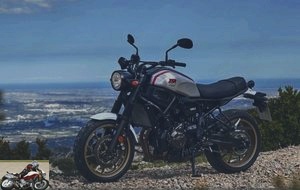 Yamaha XSR700 Xtribute review
Yamaha XSR700 Xtribute review
Discovery
Based on the standard XSR 700, itself from the MT-07, the XSR 700 XTribute adopts a decoration reminiscent of the 1981 XT 500, with its silver gray tank enhanced with black and red piping, its gold anodized rims, its indicators orange, its white mudguards, its fork bellows and even its exhaust in high position if we adopt the optional Akrapovic exhaust line fitted to our test models. These also feature the nice little Vintech LED tail light and the kickstand extension for easy kickstand on soft ground.
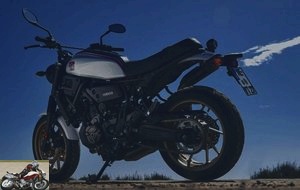 The Xtribute pays homage to the 1981 XT500
The Xtribute pays homage to the 1981 XT500
Many other optional equipment are of course offered: Ohlins shock absorber, fork spring and cartridge kit, chain guide, levers, tank pads, luggage carrier, saddlebags, etc. This is the concept. A nice base and a multitude of optional equipment to customize the bike to your taste and differentiate you from the crowd.
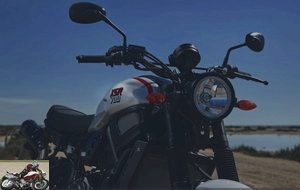 The Xtribute also comes with many optional accessories
The Xtribute also comes with many optional accessories
Equipped with the Yamaha CP2 twin-cylinder Crossplane technology (crankshaft setting at 270 ° which gives the engine more character), the XSR 700 XTribute has no shortage of attractive features. Integrated into the chassis as a load-bearing element, this modern engine with 75 horsepower at 9000 rpm and 68 Nm of torque at 6500 rpm responds to the slightest request and, although linear in its rise in speed, is just as good. pleasant that effective in use.
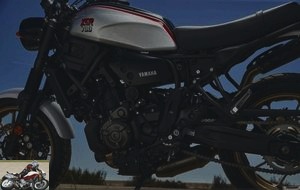 It is always the twin-cylinder CP2 which is at work
It is always the twin-cylinder CP2 which is at work
Light (188 kg all full), the XSR 700 XTribute receives a wider (+ 40mm) and higher “Trial” handlebar than the standard model, a flat saddle in one piece (30mm higher), footrests All-terrain type with removable rubbers, ten-spoke gold anodized rims and Pirelli MT 60 RS tires with more pronounced lugs. Braking is provided by a double front “petal” disc with double piston calipers and a single rear piston disc, assisted by non-disengageable ABS.
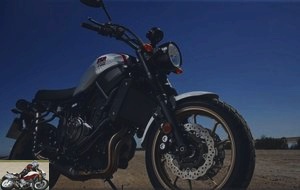 The fork is dressed in bellows to reinforce the ‘scrambler’ side
The fork is dressed in bellows to reinforce the ‘scrambler’ side
In the saddle
Easy to access, with its 845 mm saddle height, the XSR 700 XTribute is the friend of small riders. The upright driving position is pleasant, but given my 1m78 and the relative height of the footrests, my knees are a little bent straight away. We got used to it quickly, but it was a bit surprising at the start. The seat is pretty good, with decent saddle padding. The cockpit is for its part succinct, limited to a small round dial with black background shifted on the right side as on the XSR 900. This one is entirely digital with circular tachometer, tachometer, gear indicator engaged, odometer , trips, average consumption, clock, segmented fuel gauge and various usual indicator lights on the edges of the dial.
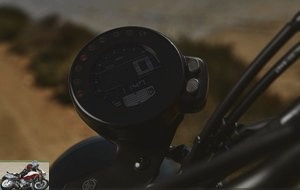 Entirely digital, the instrumentation is minimalist
Entirely digital, the instrumentation is minimalist
Contact
With our test models equipped with the Akrapovic line and silencer, starting the XSR 700 XTribute is a real pleasure. This appendix indeed brings a real plus, visually and aesthetically of course, but especially in terms of hearing. This exhaust literally brings this bike to life. Already at a standstill, the hoarse, clicking sound of this exhaust as soon as you tickle the accelerator is a real invitation to arousal. So much so that we would have liked to have this relatively expensive element (1300 €) as standard. This is the whole paradox of this vintage-style motorcycle, but equipped with a modern and hyper-agile chassis, as well as a surprisingly efficient and playful engine. Very much in the spirit of Faster Sons !
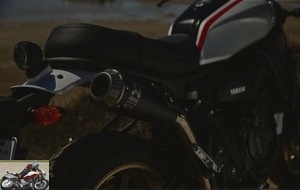 When stopped, the optional Akrapovic silencer sets the tone
When stopped, the optional Akrapovic silencer sets the tone
In the city
From the first laps of the wheels, the XSR XTribute displays a good overall balance and good line stability which will reassure beginners from the outset. The wide handlebars allow good control of the direction and the angle takes place with roundness and progressiveness. The turning radius is quite good, which makes it easier to maneuver and allows you to turn around more quickly in a narrow street. The reports are linked quickly and precisely, the twin-cylinder CP2 also showing exceptional flexibility, accepting to resume under-revving without knocking from 2000 rpm. Acceleration metering is very precise and the clutch requires little lever effort.
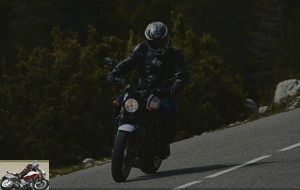 The wide handlebars, aided by a good turning radius, facilitate maneuvering
The wide handlebars, aided by a good turning radius, facilitate maneuvering
On the highway
Given the little wind protection of this bike, its primary purpose is not to line up from the bollard on the motorway, which does not prevent it from being at ease on expressways. Stalled in sixth at 5,000 rpm, we sailed quietly at legal speeds, knowing that we have sufficient power reserve to exceed 200 km / h if we were not afraid of losing our license. The revving of the CP2 unit is perfectly linear, but the stimuli remain energetic as soon as the throttle is open frankly, even if it means dropping a gear to obtain a more lively reaction. At stabilized speed, on the other hand, we note insidious vibrations at the level of the handles, especially the right.
 Protection is very limited at high speed
Protection is very limited at high speed
On departmental
Leaving Tortosa for the small winding roads of the Catalan reliefs, our test XSR 700 XTributes can finally make their Akrapovic Titanium silencers sing. The melody that escapes is truly divine, punctuating each gas stroke and revving with a truly exhilarating and addicting tone. However, we are far from the sound of a free exhaust since it is approved, but the result is simply stunning.
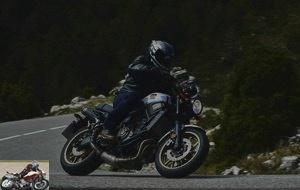 The XTribute on the small roads
The XTribute on the small roads
Hyper agile, the XSR 700 XTribute is devilishly effective in conquering the summits. The grip of the Pirelli MT 60 RS is amazing and allows you to adopt a very sporty driving rhythm. The machine demonstrates excellent handling and heading precision. The wide handlebars facilitate rapid passage from one turn to another without the need for excessive force thanks to the 25 ° 50 caster angle and the relatively short wheelbase (1405 mm) of this lightweight motorcycle and very agile.
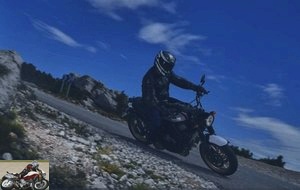 The Yam is very agile on small roads
The Yam is very agile on small roads
The suspension copes well with the stress up front but bounces a bit more at the rear, causing small dribbles from the rear wheel when combined with deceleration from heavy front braking and bumpy roads. This is where you can feel the ABS trigger preventively, increasing the braking distance in spite of itself.
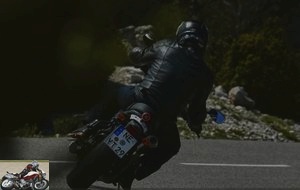 Rear suspension is felt on bumpy roads
Rear suspension is felt on bumpy roads
The twin-cylinder CP2 is having fun and demonstrating its full potential in this road context. After 4000 rev / min the cavalry is already more present and the response to the handle more lively in revival. The operating range of this engine is quite wide, but the best performance is towards the maximum torque zone at 6,500 rpm. The linearity of this twin, on the other hand, requires the pilot to use the selector regularly to gain punch with each restart or to benefit from greater engine braking during deceleration. But hey, we digress, the XSR 700 XTribute is not a racing bike, just a playful and pleasant bike to use on a daily basis as for Sunday rides. A good little motorbike !
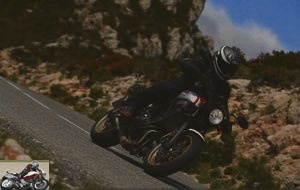 If the engine is flexible and linear, it will be necessary to play with the clutch to gain a little punch when relaunching
If the engine is flexible and linear, it will be necessary to play with the clutch to gain a little punch when relaunching
Comfort / Duo
The seating offered by the XSR 700 XTribute is quite comfortable, with decent seat padding. The riding position is natural, but I find the distance between the saddle and the footrests a little short, which means that you have to bend your legs a little more. Passenger transport is not a problem, as it has enough space and a rear frame loop to hold it in place. The footrests dedicated to him are on the other hand a bit high too, especially if he has long legs..
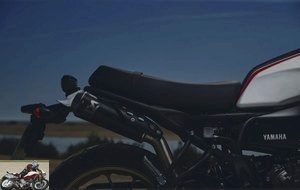 The saddle is quite comfortable
The saddle is quite comfortable
Braking
Equipped with a 284mm dual petal disc with two-piston front calipers and a single-piston petal rear disc, the XSR 700 XTribute features powerful, easy-to-dose braking, assisted by non-switchable ABS. This one is not too intrusive, but can become more so if you adopt a slightly too sustained pace because the Pirelli MT 60 RS may have good grip in the dry, they are not infallible when abrupted. a bit too much. In “normal” use, this braking is efficient and perfectly suited to the performance of this motorcycle..
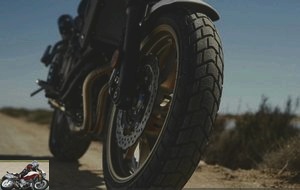 The brakes are powerful and adjustable, but the ABS cannot be disengaged
The brakes are powerful and adjustable, but the ABS cannot be disengaged
Consumption
Once again, the manufacturer announces an advantageous average consumption of 4.3 l / 100 km. Which with the 14-liter tank would offer a range of around 325 km. For our part, we rather observed an average consumption of 5.4 l / 100 km during this test, or an effective range of around 260 km. This being the case, it is true that we often put more stress on the motors during a test to push the machine compared to daily use and that it must be possible to lower this value in everyday use..
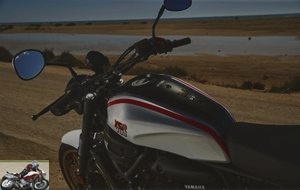 During the test, the Xtribute will have consumed an average of 5.4 l / 100 km
During the test, the Xtribute will have consumed an average of 5.4 l / 100 km
Convenient
With the absence of a screen, hand guard and luggage carrier, the practicalities are not numerous on the XSR 700 XTribute. It does have a hinged fuel cap, a warning and brake lever clearance adjustment, but that’s it.
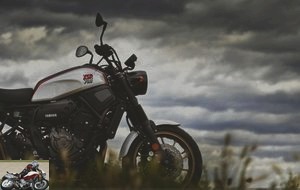 Practical aspects are reduced to the strict minimum
Practical aspects are reduced to the strict minimum
Video test
Conclusion
Alluring as you wish, the XSR 700 XTribute is a true pleasure bike, especially equipped with the optional Akrapovic exhaust line. A playful and easy-to-access motorbike that is sure to give you a kick out of every ride. A motorcycle that is not sold on the other hand with a base price of € 8,799 (or € 800 more than a standard XSR 700), to which it will be necessary to add around € 1,300 to take advantage of the Akrapovic exhaust, or even more if you want some additional accessories. In short, we quickly exceed 10,000 €, which may seem expensive for a 700 cm3 roadster / scrambler. However, you just have to try it to fall in love with it and when you love you don’t count, it seems. !
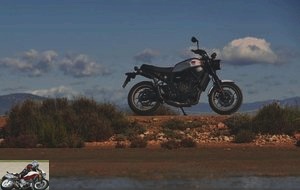 The Yamaha XSR700 Xtribute
The Yamaha XSR700 Xtribute
Strong points
- Efficient motor
- Agile and playful chassis
- Satisfactory comfort
- Nice look
Weak points
- High price, with and without options
- Barely readable counter
- Handlebar vibrations
The technical sheet of the Yamaha XSR700 Xtribute
Test conditions
- Itinerary: around 150 km on a mixed city, expressway and small mountain roads route.
- Weather forecast: cloudy then sunny, dry roads
- Starting mileage: 690 km
- Problem encountered: RAS
Related articles
-
Backpacker at heart Twin-cylinder CP2 of 689 cm3, 74 hp and 68 Nm, 204 kg full made, 9,699 euros Stopped at the end of 2016 due to Euro 4 standards, the…
-
3 cylinders, 847 cm3, 115 hp, 8.9 m / kg, 195 kilos, € 12,599 A limited series of 695 pieces in collaboration with Abarth October 2007: Valentino Rossi…
-
Upgrading Unchanged since 2012, the Yamaha 450 WRF has this time been completely revisited. Derived from the excellent YZF cross model, this new Yamaha…
-
Alone in the world Single cylinder VVA of 124 cm3, 15 hp and 11.5 Nm, 140 kg full made, 4,599 euros Today, when you want to ride a vintage / retro /…
-
The bête noire of conformism 3 cylinders in line, 889 cm3, 119 hp and 93 Nm, 189 kg, 9,499 euros With its MT-09, Yamaha revolutionized the market for…
-
Yamaha Tracer 700 GT motorcycle test
Joys of possibilities Twin-cylinder in-line, 689 cm3, 74.8 hp, 68 Nm, 200 kg all full, available in A2, 8,999 euros. The Yamaha Tracer 700 Gt! Here is a…
-
Two-Temperaments ! At the end of the 1970s, when motorcycles with large-capacity multicylinder engines weighing a dead donkey have been in vogue for a…
-
Double-dealing ! Long announced, the Yamaha YZF-R3 Yamaha is finally out of the woods and completes the sport range of the Japanese manufacturer, halfway…
-
Yamaha MT-10 SP & Tourer Edition test
Two more road and sporty evolutions of the MT 10 4-cylinder Crossplane, 160 hp, € 14,999 and € 15,999 In 2009, Yamaha presented the Yamaha R1 Crossplane:…
-
200 hp at 13,500 rpm, 112 N.m at 11,500 rpm, 199 kilos with full fuel, from € 18,499 Is the Crossplane engine an advantage in road use ? Even if the…
There are a few of us who ask for just that. A treatment of the cylinders, an injection, two-three odds and ends and we keep the rest.
I wouldn’t have really said "vintage" but it all depends on what you mean by…

Vintage, I rather saw the bikes that run at Moto-Legendes, over 30 years old at least.
Although at the level of the look, I find that it is precisely in the 80s that the bikes began to take on a "modern" look..
Suddenly, vintage would be more in my idea the 70s and before.
I really like this bike but with a more up to date saddle shape and a slightly more 2016 counter it would certainly have been much better!
Basically with a bagster saddle (or other but more rounded) we already solve an aesthetic point.
the rest is okay but suzuki seems to want to save too much on all its models … too bad